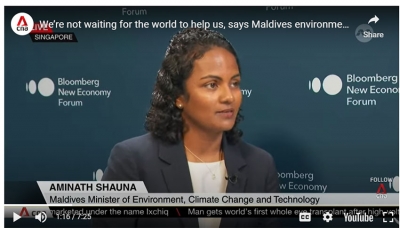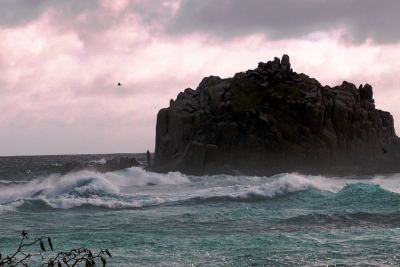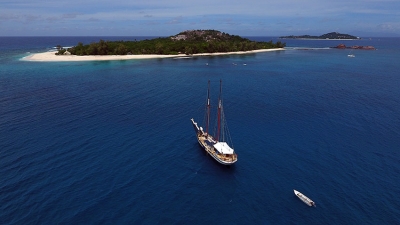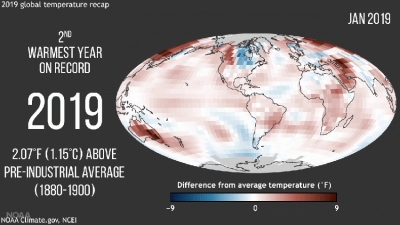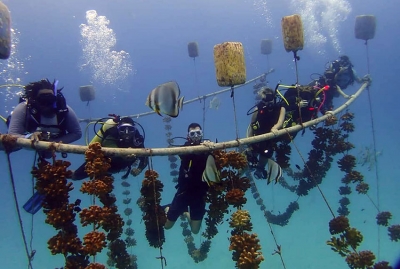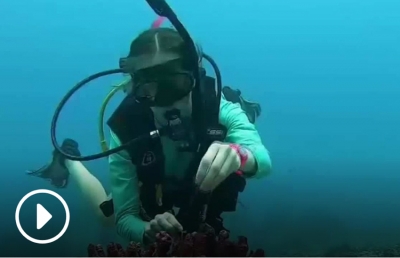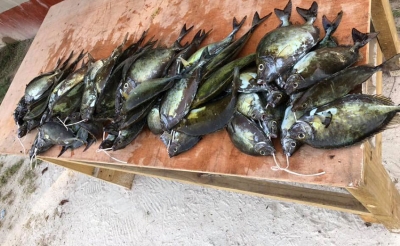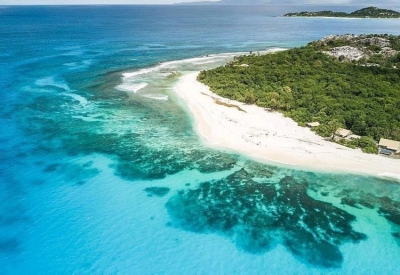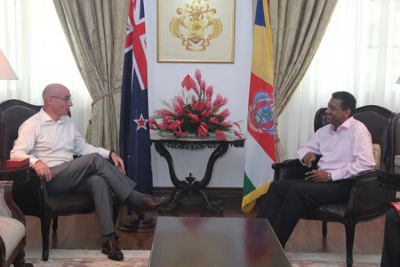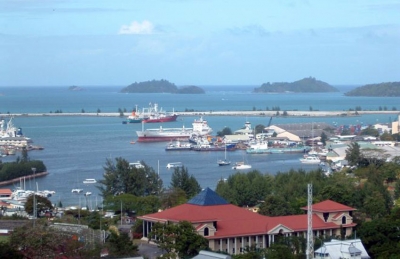Displaying items by tag: Climate Change
Tired of failed climate promises by rich nations, tiny Maldives takes matters into its own hands
(channelnewsasia.com) Tired of unfulfilled climate promises by rich countries, the Maldives is implementing its own environmental protection strategies to stay above water, says its Minister of Environment, Climate Change and Technology Aminath Shauna.
Sleeping with the enemy – if we don’t learn to live with climate change we are doomed!
By Nirmal Jivan Shah of Nature Seychelles and TOF Advisory Board Member
It is the biggest story of our lifetime – a tale of epic proportions. The plot up to now: How is climate change affecting us and how do we cope?
There is no debate in counties like Seychelles that climate change is happening. Rather, the point is how the heck do we grapple with this 500-kilo gorilla in the room? Scientists, policymakers, and NGOs all agree that there are only two ways to combat climate change. One is known as mitigation, which refers to policies and measures designed to reduce Green House Gas emissions. The other is adaptation, which includes adjustments or changes in decisions, be they at the national, local or individual level that increase resilience or reduce vulnerability to climate change. For example, relocating roads and infrastructure further inland from the coasts to reduce vulnerability to storm surges and sea-level rise are examples of actual adaptation. For us in Seychelles adaptation is the only solution we can work with.
People Are To Blame
In the last 20 years, Seychelles has experienced storm surges, heavy rains, freak tides, hot seawater, El Nino, and El Nina. The man who cuts my grass has, like all Seychellois, been acutely aware of this. About 10 years ago, after disappearing for some time his sudden guest appearance in my garden was explained by ‘Chief, El Nino pe don mon poum’ (Boss, El Nino is giving me hassles). However, comedy can turn to tragedy. In 1997 and 1998 El Nino-induced rains created disasters resulting in damage estimated at around 30 to 35 million Rupees.
These so-called disasters, in many cases, have their root in a certain breed of people who believe they know better than everyone else. These are people who take short cuts in construction, who hide from physical planners, and who sneer at civil engineers. They cut into hillsides, divert steams, remove the vegetative cover, build walls on beaches, reclaim marshes, and light uncontrolled fires. What usually happens is disaster: landslips, rock falls, floods, loss of beaches, bush fires, and collapse of structures. Not only have they abused the environment but ultimately themselves and others. In many cases, it is the Government, charitable organizations, and insurance companies that have to pick up the tab.
Bye Bye Beaches
A good friend is anxious to sell what most people would regard as prime beachfront property. He has seen tidal and wave movement change over several years and believes his property is in grave danger of falling into the sea.
Everybody remembers the incredible storm surge that battered some of our islands last year. In a book published by the World Bank and the Seychelles Government in 1995, I had predicted that storm surges and coastal development would collide. “Climate change and climate variability are likely to aggravate the impacts of unsustainable development of coastal areas and resources. In turn, these impacts will further exacerbate the vulnerability of coastal areas to climate change and associated sea-level rise.”
But it’s not only that! The worse impacts of last year’s storm surge were seen in areas where infrastructure has been placed on sandy dunes or berms. These include roads like at Anse a la Mouche where some parts are situated on the dune lands and buildings and walls such as those at Beau Vallon built on the dry beach. We have put ourselves in the way of forces that no one can control. The best we can do is to plan new developments according to that famous set-back line we always talk about but few, respect.
Let’s talk about sweat, baby…
You are not wrong if you feel you are sweating more than usual. Scientists have now shown that global warming is causing humidity to increase and people to sweat more. Warmer temperatures and higher humidity will have an impact on the health and well-being of people as well as wildlife. Older persons will be at risk. Tourists may find the conditions in Seychelles too uncomfortable or stay home because it’s become less cold.
A new study published in the prestigious journal Nature shows that by 2027 Seychelles will enter a temperature hot zone never experienced before. In other words, the coldest year in Seychelles after 2027 will be warmer than the hottest year ever experienced in the last 150 years. The study’s authors refer to this tipping point as a “climate departure.”
We need to start adapting to a hotter Seychelles by re-designing infrastructure. New buildings and homes need to be designed to be cooler by adopting “green architecture”. Solar-powered fans and air-conditioning should become the norm in older buildings. Definitely, we should be researching which trees can cool urban areas faster through shade and transpiration.
The F Word
The F Word in this case is Food. I want to discuss climate change and the coming food scarcity. Seychelles ranks last in Africa as regards investment in agriculture. Superimposed on this rather grim situation comes climate change. Bad weather has greatly affected agriculture in Seychelles. Unseasonal rains damage farms and prolonged droughts cause failures and hardships. The range and distribution of pest species is increasing owing to higher rainfall and increased humidity and temperature.
Seychelles also has the largest per capita carbon footprint in Africa. A good part of this comes from the heavy reliance on imported products which include a high percentage of food items. New ways of creating appropriate food-growing is needed to build social and ecological resilience. We have to take agriculture beyond the traditional farms and make it everyone’s preoccupation so that we have a national climate-smart food production system. We should actively support household and community gardening on a country wide scale and teach climate-smart and eco-agriculture techniques. One of the concepts I’ve disseminated is “edible landscaping” which is possible in all our urban areas.
Climate Change is making me sick
Climate change may increase the threats of Chikungunya, Dengue, and other diseases spread by mosquitoes in several ways. One way is by increasing the temperatures under which many diseases and mosquitoes flourish, and another by altering rainfall patterns so that more water may become available in the environment for mosquitoes to breed.
Health officials have suggested that a law on mosquito control should be established and strongly enforced as in Singapore and Malaysia. This and other measures become more urgent as climate changes may also result in the growth of mosquito populations.
Members of the public have an important role to play to ensure that mosquito breeding grounds are eliminated. This is especially important in these difficult economic times when coping behaviors and social patterns start to weaken under the strain.
Adapt Don’t React
Preparing for climate change can save lives, but to save livelihoods we must also help people become less vulnerable and more resilient. By now all Seychellois hopefully know about disaster preparedness. Government agencies and NGOs like the Red Cross have all been discussing disaster planning. But, the disaster that occurred after Cyclone Felleng proves that people and infrastructure are just not resilient enough to cope with such events.
The problems are worsened as more people and more expensive infrastructure are established in coastal zones. Storm damage becomes costlier because the houses and infrastructure are larger, more numerous, and more elaborate than before.
The National Disaster Relief Fund, of which I am a member, has been able to assist many needy families who were affected by the Felleng-induced rains. But more Felleng-like events will occur in the future. How will the same families cope?
There are many responses but we can focus on a few. We know from experience that insurance policies, building codes, and engineering works such as drainage were very important factors that influenced how we coped with the costs of storm and flood damage following storm events. Many persons don’t seem to have flood insurance and the majority have constructed houses with inadequate storm water drainage, for example. These are the key issues that need to be focused on and enhanced since improvements could ease much suffering in the future.
Flight Not Fight
It’s a no-brainer: one looks at Port Victoria and one instantly realizes that we may already have lost the war against climate change. The commercial and fishing port, the coastguard, the fire, and emergency services, electricity generation, and depots for food fuel and cement are all located in an area that may bear the brunt of climate change impacts. Even the Seychelles International airport has been built on low-lying reclaimed land, although this was at a time when climate change was not even a concept.
These coastal zones are very likely to experience the sea-level rise, storms, and flooding. What climate change experts call the “retreat option” may be worth looking at for some of these. Alternative locations for emergency services, food and fuel storage and energy generation must be priority discussion points for a future national strategy.
I promised you a Coral Garden
In 1998, Seychelles experienced a mass coral bleaching event as a result of increased ocean temperatures, which in turn caused the collapse and death of many corals. Coral reefs are particularly important areas of marine biodiversity and breeding grounds for fish and other species upon which Seychelles’ economy relies. Reefs also act as the first line of defense from rising ocean levels.
Without healthy coral reefs, Seychelles would lose out on valuable income associated with tourism and fisheries and may also increase its vulnerability to costly risks and disasters associated with climate change.
The most exciting and innovative adaptive solution in recent times is the Reef Rescuer project being implemented around Praslin and Cousin islands. This is the world’s first large-scale project of its kind using the “coral reef gardening” method. The restoration project does not intend to “turn back the clock” but rather intends to build reefs capable of withstanding climate change impacts particularly bleaching.
Don’t be Neutral about Climate Change – Be Carbon Neutral
A few years ago there was outrage locally over an article in a German newspaper which was titled “Sylt, not Seychelles.” The newspaper was urging wealthy Germans not to fly to long haul destinations like Seychelles but rather to holiday in places much closer like the island of Sylt because of the tremendous global warming emissions caused by long-distance air travel.
A scientific paper by Professor Gossling from Sweden provides calculations that show that Seychelles tourism generates a massive ecological footprint. The conclusion is that tourism in Seychelles cannot be said to be ecologically friendly nor environmentally sustainable. This is bad news because the majority of tourists to Seychelles are Europeans who are conscious of environmental protection.
To deliver a guilt-free trip to Cousin island Special Reserve Nature Seychelles transformed Cousin into the world’s first carbon-neutral island and nature reserve by buying carbon offset credits in accredited climate adaption projects. I launched this exciting initiative at the first Seychelles Tourism Expo in the presence of the President Mr. James Alix Michel, Mr. Alain St.Ange and others. Other islands in Seychelles, such as La Digue, can now go down the carbon neutral path.
Money Lost But Social Capital Gained
“The tuna factory has closed down and I need a job”. Magda, one of my neighbors, was referring to the Indian Ocean Tuna caning factory that was temporarily closed in 1998. The Seychelles Breweries also shut down production for some time. That year, heated surface waters in the Indian Ocean caused massive coral bleaching and dramatic changes in the availability of tuna to fishing boats. The prolonged drought that followed led to the temporary closure of industries and loss of revenues in the dive based tourism sector. Unusually large downpours that came later caused massive landslips and floods.
In 2003, another climatic event which had cyclone-like effects devastated Praslin, Curieuse, Cousin and Cousine islands. The socio-economic costs were serious enough to have brought a team from the United Nations Environment Program to evaluate the damage. The Tsunami was not caused by climate change but one can easily envisage similar waves caused by a combination of sea level rise, storm surges and high tides. The impacts of the Tsunami and the torrential rains that followed led to an estimated US$300 million in damage.
The bad news is tempered by good social capital in the country. Pioneering research by British and American researchers has shown that Seychelles, of all the countries in the region, may have a high socio-economic capacity to adapt to climate change. Compared to say Kenya and Tanzania where overfishing, coral bleaching, pollution and so forth are pushing people further down the poverty trap, the high human development index in Seychelles means that people could find technological and other solutions to the crisis
People Power
President James Michel has said that the populace should share ownership of coastal areas. The President made this landmark statement in 2011 during his visit to erosion-prone coastal areas. The President said the public cannot rely on government to do everything. I believe this is one of the most important policy statements about the environment in the last 30 years.
In the past, the policy in Seychelles and the way some government officials acted towards climate change and other environmental concerns have left citizens and groups somewhat sidelined when it comes to actual adaptation action. Only some civic groups have been able to break through to deliver successful results.
It is now established in international circles that “people power” is at the heart of the effort to beat climate change. The European Environment Agency, for example said that “the task is so great, and the timescale so tight we can no longer wait for governments to act.”
The answer therefore to adapting to climate change is in the hands of the many making up the populace not the few in government. But in reality how can this are done? Can the power be delegated from the responsible Ministry to civil society organizations and does the law provide for “people power?”
Yes, it’s all there. Article 40(e) of the Seychelles Constitution says “It is a fundamental duty of every Seychellois to protect, preserve and improve the environment.” This provides a strong legal right for civil society to be a principal actor.
This blog originally appeared in the International Coalition of Tourism Partners Member News and the Ocean Foundation Blog in 2014
IUCN Congress Newsletter: Remaining ocean champions, not victims
Cousin Island Special Reserve was the island famously bought for conservation by BirdLife International in 1968, and it is now managed by Nature Seychelles. I visited the island at the beginning of the year to inspect catastrophic coastal erosion that had occurred, and it was the first time I had seen anything like it since we took over management.
The last decade was earth's hottest in recorded history
Earth temperatures soared in the decade that just ended according to local and global reports, with 2019 being the second hottest year after 2016.
(Seychelles News Agency) As coral becomes increasingly threatened, Seychelles helps six countries practice coral restoration
(Seychelles News Agency) - Community leaders and reef practitioners from six western Indian Ocean countries affected by climate change are now better equipped to carry out coral reef restoration following an intensive training session.
(Sky News Report) Deep Ocean Live: Climate change is killing the ocean's coral reefs
Rising sea temperatures are having a devastating impact on the coral reefs surrounding the holiday islands of the Seychelles. 'Coral gardeners' are trying to save the reef – but they warn it won't be enough until the world stops the oceans warming. Sky News was taken to the reefs off Cousin Island - here's what they saw: http://po.st/ouhY0b
Study: Climate change has taken a toll on fisheries globally
Climate change has taken a significant toll on many of the world's fisheries, and overfishing has magnified the problem, according to a new paper. Ocean warming led to an estimated 4.1% drop in sustainable catches, on average, for many species of fish and shellfish from 1930 to 2010.
Bangladesh, Seychelles, and Cocos (Keeling) Islands have relatively high rates of sea level rise, study says
Danger, Danger! A new study reveals that Seychelles, Bangladesh and Cocos Keeling Islands have high rates of sea level rise. These regions are therefore highly vulnerable to coastal flooding induced by the accelerating sea level rise in future decades, posing significant threats to coastal communities and ecosystems. The findings published in the Journal of Hydrology indicate that vertical land motion is an important factor affecting sea level changes for the regions of Seychelles and Cocos Islands. There is a strong relationship between air temperature and sea level rise for all studied regions. The study, Characterizing the Indian Ocean sea level changes and potential coastal flooding impacts under global warming, is a first attempt to examine regional changes in sea level of the Indian Ocean.
Seychelles News Agency: Blue economy, climate change top the agenda between Seychelles, New Zealand.
Seychelles News Agency: Seychelles and New Zealand, both members of the Commonwealth, will cooperate in the fields of economic relations, the blue economy, and climate change, the newly accredited High Commissioner said on Tuesday.
Ports and harbors are in harm’s way because of climate change
It’s a no brainer: one look at Port Victoria and one instantly realizes that seaports are located in areas that will bear the brunt of climate change impacts. These areas are coastal zones likely to experience sea-level rise, storms and flooding. One would think therefore that port authorities around the world would be planning for climate adaptation.
